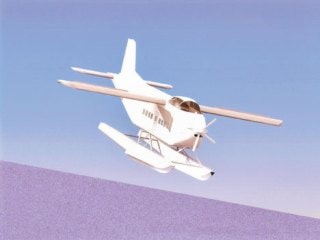By Harley Richards
Advocate business editor:
Ponoka is on a short list of communities favoured for an aircraft manufacturing plant that could eventually employ a thousand people and generate annual economic benefits of $300 million.
Aeromax Loadstar Ltd. is seeking a site and investors for the project, which would involve the production of a utility aircraft with a variety of applications. Output is projected to ramp up to 12 planes a month within four years, with these expected to sell for about $2.55 million each.
Terry Ferguson, an Edmonton-based investment adviser with Union Securities Ltd. of Vancouver, is project facilitator for Aeromax Loadstar. He’s also an investor in the company.
Ferguson said Aeromax Loadstar’s parent company, Aeromax International Inc. of Seattle, decided that Alberta would be a good location for the manufacturing facility because of the relatively low business costs here.
He’s met with officials from municipalities across the province, and Ponoka and Wetaskiwin are the current frontrunners. Ferguson said these communities are able to satisfy Aeromax Loadstar’s requirement of a 15-acre parcel near a runway, and have also been the most supportive in helping the company move forward.
“They’ve been willing to take the next step.”
Brad Watson, the Town of Ponoka’s chief administrative officer, said he’s excited about the prospects of Aeromax Loadstar landing in town.
“Anytime that you can find a business of that magnitude, it’s promising for the community.”
He added that the aerospace industry is clean and high-tech, and would produce considerable economic benefits for the region.
Watson also said he and other town officials are satisfied that the project and its backers are legitimate.
“We’ve done extensive research on (Aeromax International president and CEO Patrick) Palmer, we’ve done extensive research on his product, his people, what is the potential.”
To proceed, Aeromax Loadstar requires accredited investors who will provide $14 million for the project. They would become limited partners in the venture, with Aeromax International the general partner.
Once the money is in place, Palmer would move to the site with a team of about 30 design and manufacturing staff, said Ferguson. A flying prototype would be developed, followed by certification and production.
The company’s staff would increase over time, with about 40 expected by the end of its first year of operations. This tally would increase gradually, and then jump sharply in the fourth year as Aeromax Loadstar goes into commercial production. It is expected to level out at about 1,027 in the sixth year, with production anticipated to hit 144 planes a year by the seventh year.
Technical staff is expected to come from colleges and technical schools across Canada, with the underutilized workforce at Hobbema and displaced workers from the auto sector cited as potential sources of labour.
Additional capital for the business is expected to come from financial institutions as the project proceeds, with Aeromax Loadstar expected to become a publicly traded company after about six years.
A market feasibility conducted on behalf of Aeromax Loadstar has concluded that there is a demand for more than 1,300 of the planes in North America — a figure Ferguson thinks is conservative.
Additional information about Aeromax Loadstar can be fojnd online at www.aeromaxloadstar.com.
Contact Harley Richards at hrichards@reddeeradvocate.com
